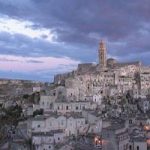The cave landscape code revealed in Matera by 50 world experts
The conference was organized, from 21-23 November 2013, on the occasion of the twentieth anniversary of the inscription of the “City of Stones” in the UNESCO World Heritage List and celebrates the nomination of Matera in the short list of 6 of the 21 candidate cities, along with Siena, Perugia-Assisi, Lecce, Cagliari, Ravenna, as European Capital of Culture 2019
In the City of the Stones the history of humanity that goes from the first cave graffiti and flint tools to the creation of the first forms of family alliance, to the connection and communication from the invention of printing to electricity, to the present day with complete interconnection exemplified in the qr code.
In Matera, UNESCO wants to tell millennia of the history of civilization in terms of the construction of identity and social cooperation in the continuous process of landscape construction: from the first graffiti of caves and the tools of flint to the creation of the first forms of family alliance, the neighborhood, and the community, giving voice to 50 world experts who will have to unravel the cave landscape code. The conference is organized in several sessions that present the vast international panorama of the world of caves, from prehistory to habitats and stone cities to the experiences of restoration and contemporary achievements. The history of humanity is a continuous journey towards connection and communication from the art of the caves to the press and electricity up to the complete contemporary interconnection exemplified in the qr code. The conference will take place at Palazzo Lanfranchi, from 21-23 November 2013, on the occasion of the twentieth anniversary of the registration of the “City of the Stones” in the UNESCO World Heritage List and to celebrate the newly nominated Matera in the short list of 6 of the 21 candidate cities together with Siena, Perugia-Assisi, Lecce, Cagliari, Ravenna as European Capital of Culture 2019. The conference that represents a new stage of the journey towards the new UN International Convention on Landscape, is organized by IPOGEA and the International Traditional Knowledge Institute – UNESCO together with Matera 2019, the University of Basilicata, the Superintendency and local administrations. Matera after the decision of the International Commission of the EU and the Ministry of Cultural Heritage, once again, raises its challenges and cultural provocations with a conference with ambitious and current topics. The purpose of the international gathering (the first meeting took place in Florence in 2012) is to continue this process destined to change the history of the definition of the landscape and its protection, devoting in particular the reflection to the Città di Pietra as a model of knowledge for the correct management of ecosystems. The conference, dealing with the theme of landscape as a mental perception and the realization of the humanity-nature matrix of identity, intends to prefigure a new model with low waste of resources, integrated, nomadic, slow, labyrinthine, small-scale. Autopoietic communities, not expensive and capable of renewing the resources of ecosystems show the possibilities of resilience and survival. The traditional techniques of Matera – water collection; soil protection; cave living; natural architecture; passive geothermal energy; the type of urban structure – they are today a model for the most advanced bio-architecture research, on the sustainable city, the green economy and the issue of landscape quality, production, food, life and the rebirth and preservation of the territory.

The philosophy of the conference is that a different cognitive paradigm for reacting to the global challenge and prefiguring a new model can draw on ways of thinking placed on the edge of modernity. Among these, the Landscape of the Caves synthesizes a thought, troglodyte, with a low waste of resources, labyrinthine, nomadic, passive, slow, which offers indications and solutions of great topicality that can still be found today in the Cities carved in the stone. “The reversal of the cognitive paradigm – says the architect Pietro Laureano, UNESCO expert for arid areas and endangered ecosystems – has already been started in the anthropological reflection, which no longer sees the Paleolithic as a backward stage of knowledge overcome by successive evolutions but a refined and advanced level that had anticipated important acquisitions generally considered successive (art, sedentarization, knowledge of the environment, symbolism, community organization, management of flora and fauna), and by the environmental awareness that today proposes precisely these issues denied with the dominance of affluent societies “. The UNESCO kermesse was set in the location of Mel Gibson’s Passion of the Christ among the fascinating scenery of one of the oldest cities in the world, to celebrate the twentieth anniversary of the inclusion of the Sassi in the UNESCO World Heritage List that took place in 1993. In that moment the proposal was not obvious because then the Italian sites included in the list were only Venice, Florence, Pisa, Rome, San Gimignano plus the rock graffiti of the Val Canonica and the church of S. Maria alle Grazie with Leonardo’s Last Supper in Milan. Italy was therefore under represented and the South had no registration. The non-courtly goods of popular tradition and the problematic cultural landscapes that Icomos and Unesco were elaborating to make the list not all the isolated monuments, but a representative list of the historical and landscape heritage of human cultures in all their varieties and manifestations, even the most apparently poor and less precious. The candidacy of the Sassi of Matera was part of this innovative and, at the time, challenging problem. Today, thanks also to the emulation process triggered by the inclusion of Matera, the Italian assets on the list are the most numerous in the world and the recovery of the Sassi of Matera has become an international example of success and resilience. 20 years after that registration, Matera still proposes itself as one of the Italian cities that are candidates for the 2019 European Capital of Culture, accepting new challenges and goals, proposing itself, once again, as an example and a valid appeal for the re-launch of the whole of Italy.








